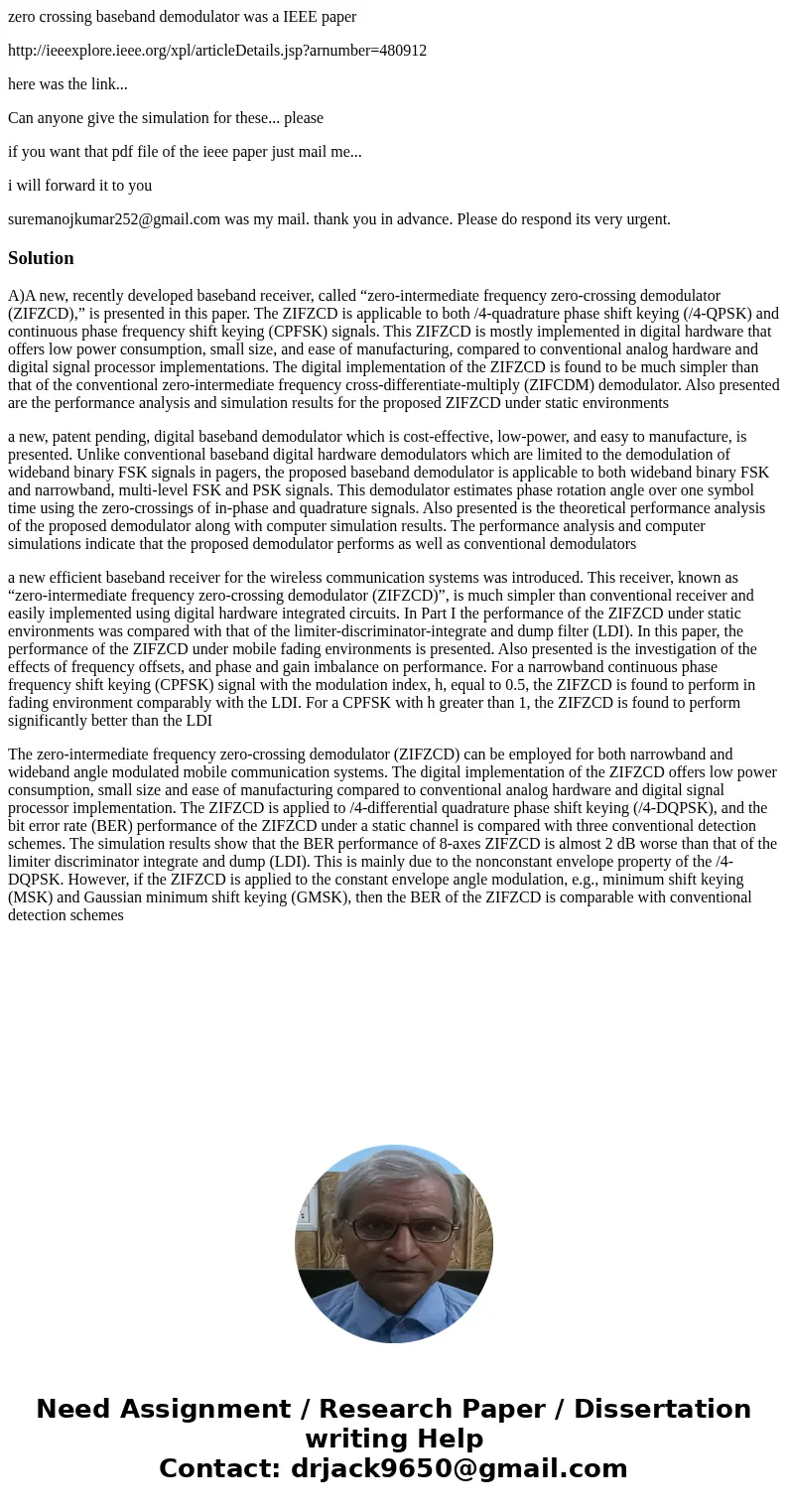zero crossing baseband demodulator was a IEEE paper httpieee
zero crossing baseband demodulator was a IEEE paper
http://ieeexplore.ieee.org/xpl/articleDetails.jsp?arnumber=480912
here was the link...
Can anyone give the simulation for these... please
if you want that pdf file of the ieee paper just mail me...
i will forward it to you
suremanojkumar252@gmail.com was my mail. thank you in advance. Please do respond its very urgent.
Solution
A)A new, recently developed baseband receiver, called “zero-intermediate frequency zero-crossing demodulator (ZIFZCD),” is presented in this paper. The ZIFZCD is applicable to both /4-quadrature phase shift keying (/4-QPSK) and continuous phase frequency shift keying (CPFSK) signals. This ZIFZCD is mostly implemented in digital hardware that offers low power consumption, small size, and ease of manufacturing, compared to conventional analog hardware and digital signal processor implementations. The digital implementation of the ZIFZCD is found to be much simpler than that of the conventional zero-intermediate frequency cross-differentiate-multiply (ZIFCDM) demodulator. Also presented are the performance analysis and simulation results for the proposed ZIFZCD under static environments
a new, patent pending, digital baseband demodulator which is cost-effective, low-power, and easy to manufacture, is presented. Unlike conventional baseband digital hardware demodulators which are limited to the demodulation of wideband binary FSK signals in pagers, the proposed baseband demodulator is applicable to both wideband binary FSK and narrowband, multi-level FSK and PSK signals. This demodulator estimates phase rotation angle over one symbol time using the zero-crossings of in-phase and quadrature signals. Also presented is the theoretical performance analysis of the proposed demodulator along with computer simulation results. The performance analysis and computer simulations indicate that the proposed demodulator performs as well as conventional demodulators
a new efficient baseband receiver for the wireless communication systems was introduced. This receiver, known as “zero-intermediate frequency zero-crossing demodulator (ZIFZCD)”, is much simpler than conventional receiver and easily implemented using digital hardware integrated circuits. In Part I the performance of the ZIFZCD under static environments was compared with that of the limiter-discriminator-integrate and dump filter (LDI). In this paper, the performance of the ZIFZCD under mobile fading environments is presented. Also presented is the investigation of the effects of frequency offsets, and phase and gain imbalance on performance. For a narrowband continuous phase frequency shift keying (CPFSK) signal with the modulation index, h, equal to 0.5, the ZIFZCD is found to perform in fading environment comparably with the LDI. For a CPFSK with h greater than 1, the ZIFZCD is found to perform significantly better than the LDI
The zero-intermediate frequency zero-crossing demodulator (ZIFZCD) can be employed for both narrowband and wideband angle modulated mobile communication systems. The digital implementation of the ZIFZCD offers low power consumption, small size and ease of manufacturing compared to conventional analog hardware and digital signal processor implementation. The ZIFZCD is applied to /4-differential quadrature phase shift keying (/4-DQPSK), and the bit error rate (BER) performance of the ZIFZCD under a static channel is compared with three conventional detection schemes. The simulation results show that the BER performance of 8-axes ZIFZCD is almost 2 dB worse than that of the limiter discriminator integrate and dump (LDI). This is mainly due to the nonconstant envelope property of the /4-DQPSK. However, if the ZIFZCD is applied to the constant envelope angle modulation, e.g., minimum shift keying (MSK) and Gaussian minimum shift keying (GMSK), then the BER of the ZIFZCD is comparable with conventional detection schemes

 Homework Sourse
Homework Sourse